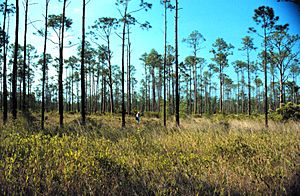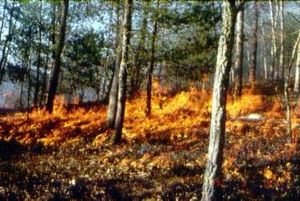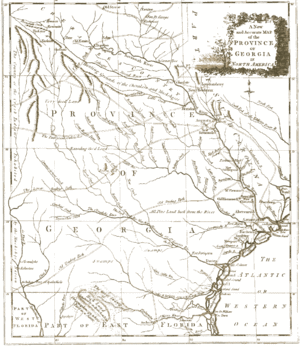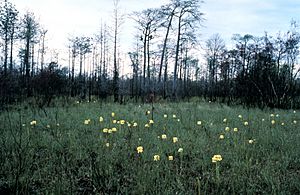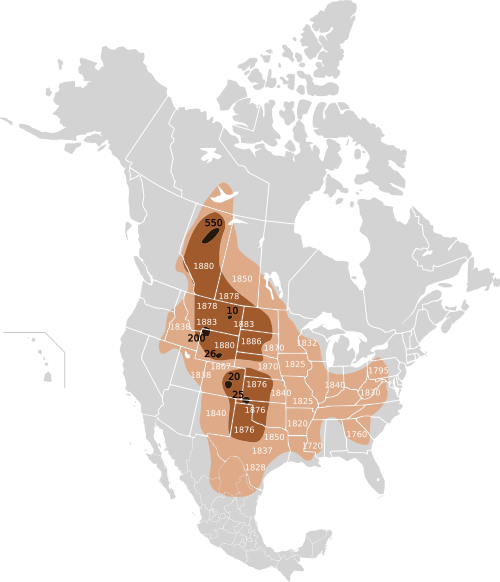Eastern savannas of the United States facts for kids
The eastern savannas of the United States were huge open grasslands and forests that covered much of the southeastern part of North America until the early 1900s. These areas were special because they depended on fire ecology, meaning fires helped keep them healthy. The ground was mostly covered with low-growing herbs and grasses.
Fires were very important for these savannas. They were often started by lightning from frequent thunderstorms or by Native Americans. Most of these fires burned the small plants and leaves on the ground, but they didn't usually harm the big, old trees. Before humans arrived about 15,000 years ago, lightning was the main cause of fires. This region had more wind and lightning storms than almost anywhere else in North America! Later, when European settlers came, they also used fire to manage the land, just like they did in their home countries.
In the southern pine savannas, fires happened very often, usually every 1 to 4 years. After settlers arrived, fires became even more frequent, burning every 1 to 3 years. In areas with oak and hickory trees, fires happened less often, perhaps every 3 to 14 years, but people still used fire to keep trails clear.
Contents
Ancient Plants of the Southeast
The plants in the southeastern United States haven't changed much in the last 20,000 years. Even during the Last Glacial Maximum (about 18,000 years ago), when glaciers covered much of North America, the plant communities in the Southeast stayed mostly the same. This is why the Southeast has so many unique plants and a lot of different types of genes.
About 18,000 years ago, forests with trees like oak, hickory, chestnut, and southern pine were common. Other trees like walnuts, beech, and sweetgum were also found. Grasses, sedges, and sunflowers grew everywhere. Large forests, similar to today's lowland forests, grew along big rivers like the Mississippi.
Humans arrived about 5,000 years after the glaciers melted. Forests expanded northward, and only a few northern-type plants remained in high places like the Appalachian Mountains. Pine forests and broadleaf evergreen trees grew mostly along the Atlantic coastal plain.
Around 9,000 years ago, the climate became warmer and drier. This led to a big increase in prairies and savannas across the region. Oak and oak-hickory forests that liked dry conditions also grew. Cooler-climate plants moved north or to higher elevations, and some even disappeared from the region. This warming period also connected the eastern grasslands and savannas to the huge grasslands of the central United States.
After this warm period ended about 5,000 years ago, the climate cooled and got wetter. Plants moved around again, and new types of forests formed, which looked a lot like the southern forests we see today. Grasslands and savannas shrank and moved westward.
About 4,000 years ago, Native American cultures in the region started farming. They also began using fire widely. They intentionally burned plants to clear the forest floor, which made it easier to travel. It also helped herbs and berry plants grow, which were important for food and medicine.
It's believed that Native American populations decreased significantly about 500 years ago. This meant that when the first Europeans arrived, the forests were changing quickly. They were becoming denser and more closed-off because there were fewer people to manage them with fire.
How Savannas Changed
In the Northeast, Native Americans often burned the oak-hickory forests. This created open areas called "oak openings," "barrens," and prairies. Fires happened almost every year. After a large number of Native Americans died about 500 years ago, these open areas became dense forests again.
When Europeans settled, fires still happened, but less often, about every 2 to 10 years. In the early 1700s, a North Carolina law even required pastures to be burned every March!
In the Southeast, longleaf pine trees were very common in savannas and open forests. These forests once covered a massive area, about 92 million acres (372,000 square kilometers), from Virginia to Texas. This was 36% of the region's land! Sadly, less than 1% of these original forests remain today.
Savannas usually had tall grasses, about 3 to 6 feet (1 to 2 meters) high. The Southeast also had the Black Belt prairie region, which included a type of tallgrass prairie. Much of this area was open grassland. Even in the 1830s, about 11% of the Black Belt was still prairie. The largest prairie in the southern Atlantic coastal plain was in the Florida panhandle.
Why Savannas Disappeared
English colonists loved the longleaf pine trees. They were tall and straight, perfect for building ships and masts. The wood and sticky pine tar were also used for many other things. The bottom of the famous ship USS Constitution was made from a single longleaf pine log!
However, harvesting these trees was limited until about 1900. At the start of the 20th century, too many longleaf pine trees were cut down. Also, livestock like cows ate the young pine seedlings, stopping new trees from growing.
Around 1924, people started trying to stop all fires in forests. Groups like the "Dixie Crusaders" told people that burning woods was bad. The paper industry also encouraged growing other types of pines like loblolly and slash pines. As fires were stopped, dead leaves and branches piled up on the forest floor. This made future fires much more dangerous and intense. Without fire, other plants grew tall and shaded out the young longleaf pines. The savannas slowly turned into dense mixed hardwood forests.
After World War II, people began to understand that using fire in a controlled way was actually good for the forests. Today, about 6 million acres (24,000 square kilometers) are burned each year to help manage the land.
Where Savannas Still Exist
More than 98% of the eastern savanna areas, especially those with longleaf pine, have disappeared.
However, some savanna and prairie areas still remain in places like:
- Apalachicola National Forest, Florida
- Kissimmee Prairie Preserve State Park, Florida
- Grand Bay National Wildlife Refuge, Alabama
- Okefenokee National Wildlife Refuge, Georgia
- Croatan National Forest, North Carolina
- Green Swamp Preserve, North Carolina
- Pine Barrens, New Jersey
The largest continuous areas of pine savanna habitat are found at:
- Blackwater River State Forest, Florida
- Conecuh National Forest, Alabama
- Eglin Air Force Base, Florida
Plants of the Savanna
Here are some plants you might find in these special savanna areas:
- Trees
- Blackjack oak
- Post oak
- Longleaf pine
- Loblolly pine (in wetter spots)
- Slash pine (in wetter spots)
- Grasses
- Cane (forming thickets along streams)
- Little bluestem
- Wiregrass
- Woody Understory (smaller shrubs and plants under the trees)
- Gallberry
- Saw palmetto
- Wax myrtle
Some plants that are not native but grow well with fire include:
- Cogongrass
- Japanese climbing fern
Animals of the Savanna
Many animals lived in the southeastern savannas:
- Plains bison (from about 1550 to 1880)
- Bachman's sparrow
- Brown-headed nuthatch
- Southeastern fox squirrel
- White-tailed deer
- Elk
- Flatwoods salamanders
- Gopher tortoise
- Indigo snake
- Red-cockaded woodpecker
- Red wolf
- American black bear
- North American cougar
Animals living in prairie parts of the savanna included:
In the northeastern savanna, there was once the Heath hen (now extinct).


